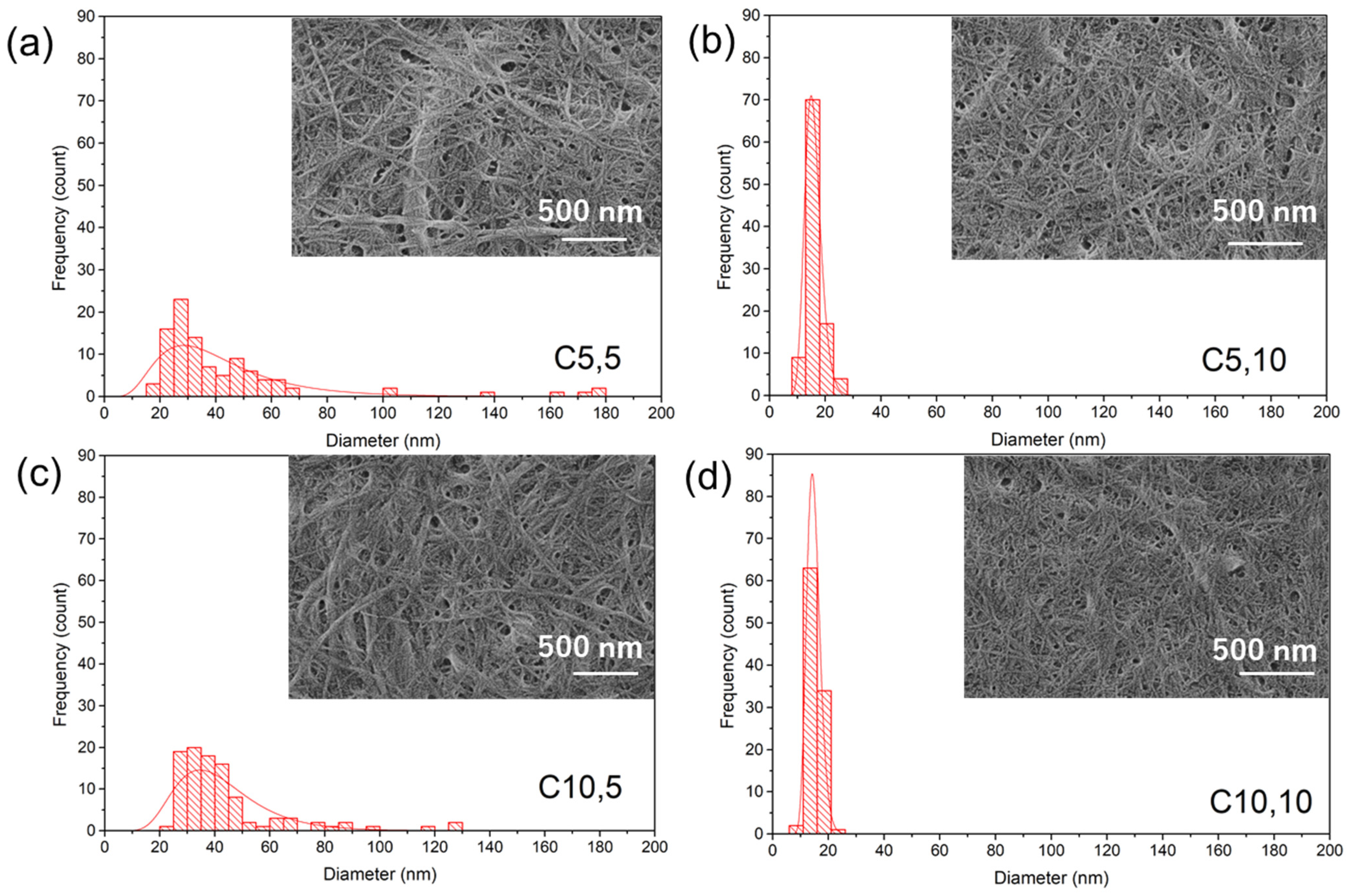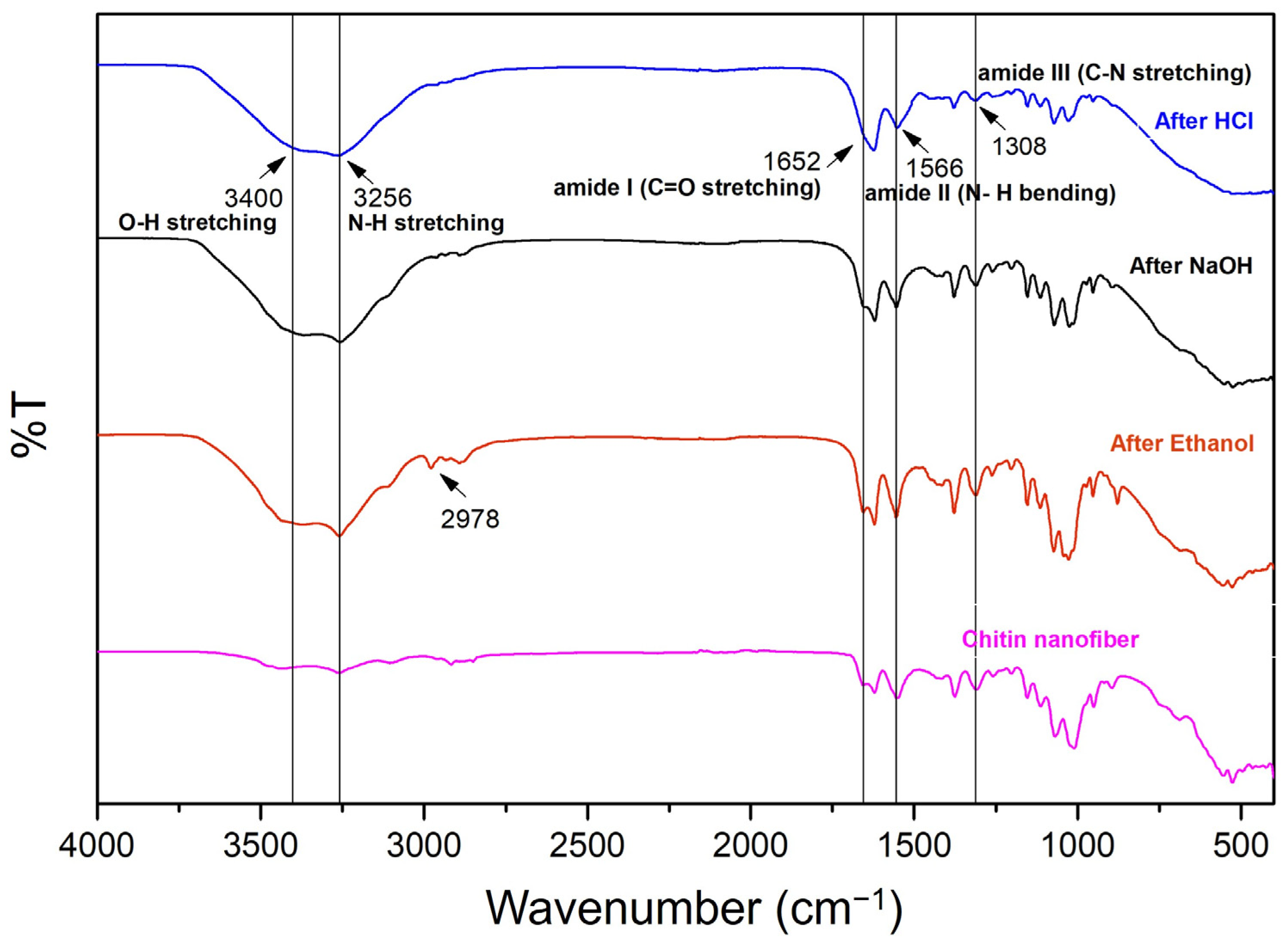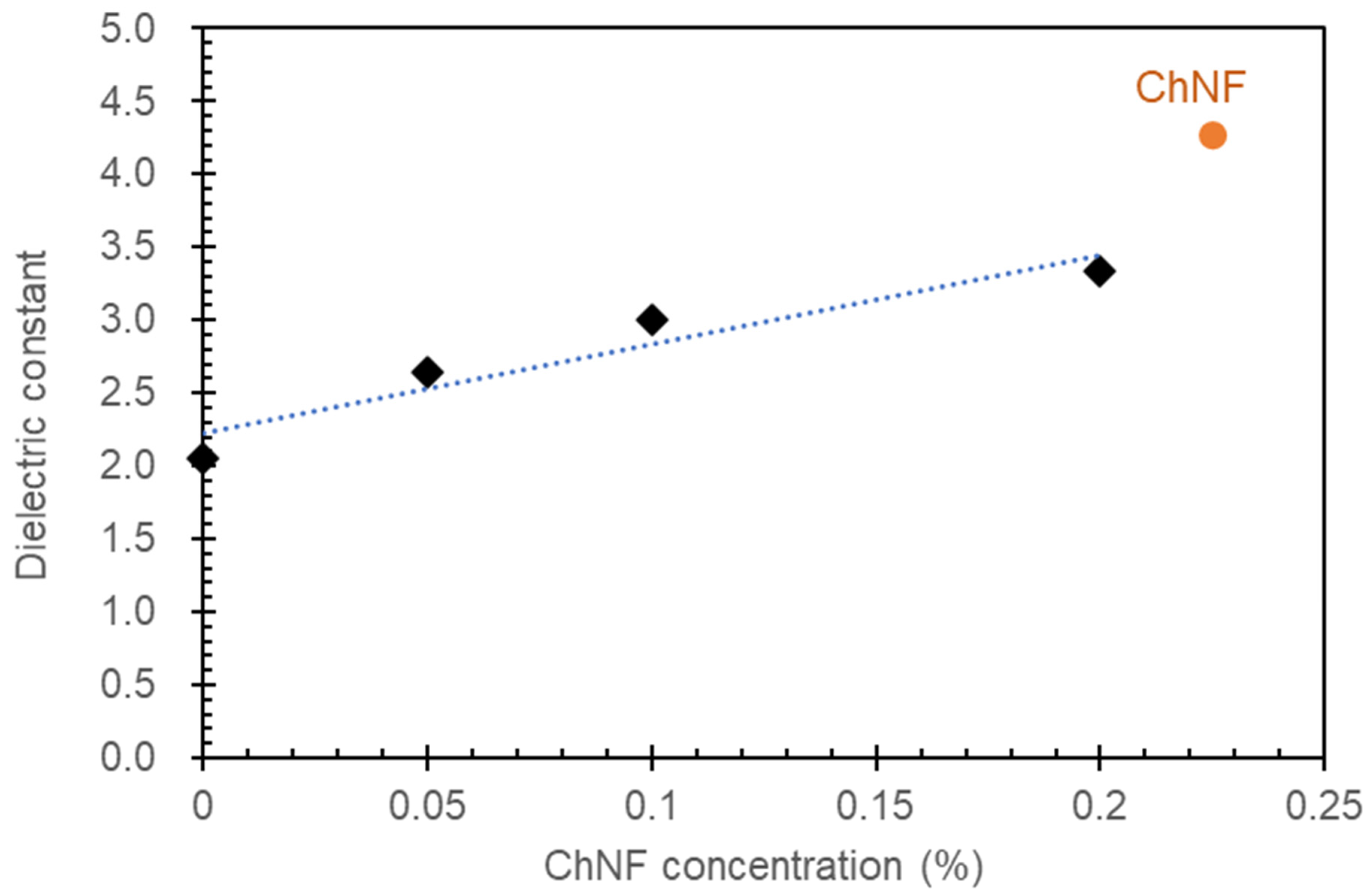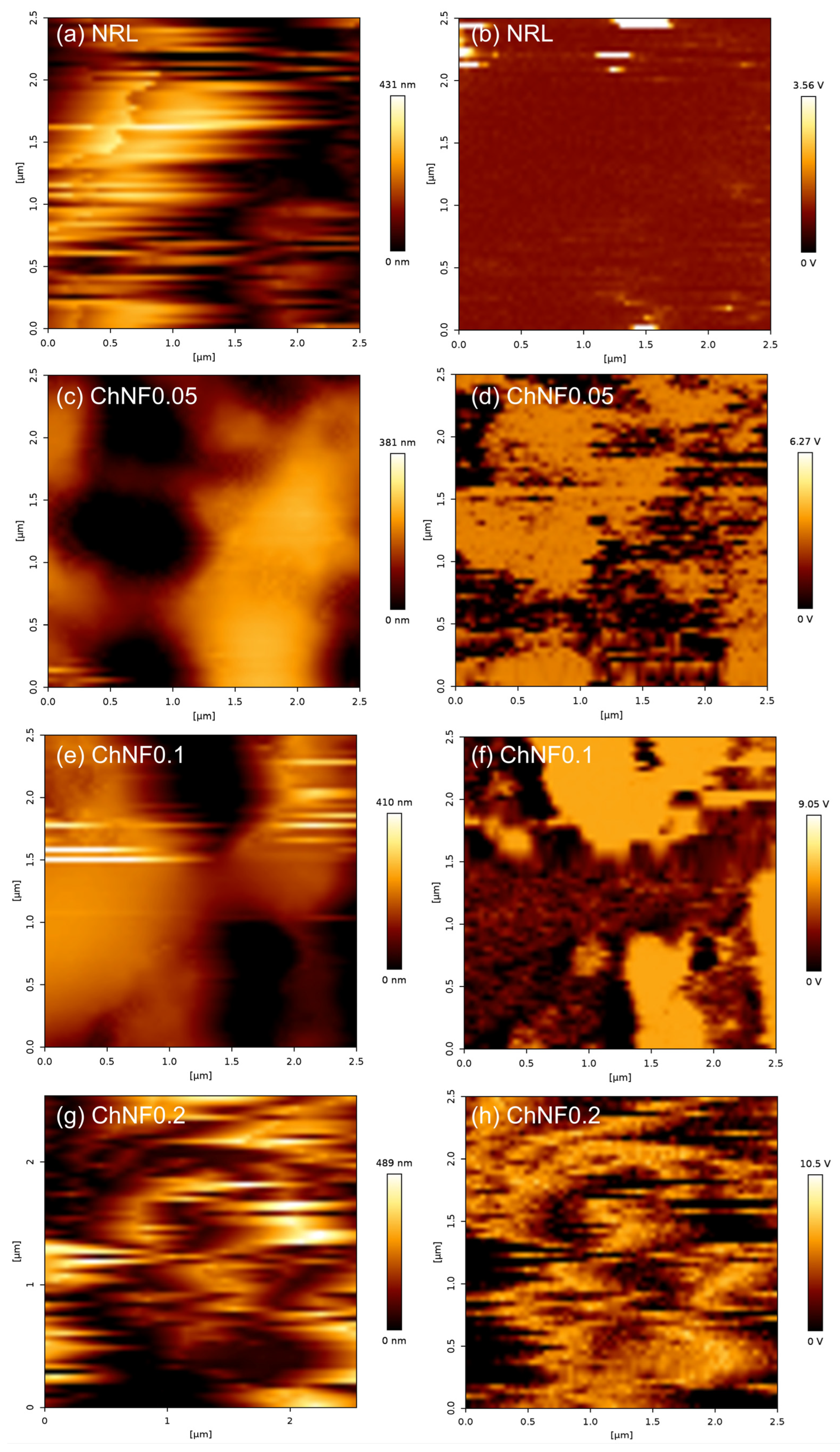Preparation of Chitin Nanofibers and Natural Rubber Composites and Their Triboelectric Nanogenerator Applications
Abstract
1. Introduction
2. Materials and Methods
2.1. Preparation of Chitin Nanofibers
2.2. Preparation of Natural Rubber and Chitin Nanofiber Composites
2.3. Characterization
2.4. Fabrication of Triboelectric Nanogenerators Based on Natural Rubber and Chitin Nanofiber Composites
3. Results and Discussion
4. Conclusions
Supplementary Materials
Author Contributions
Funding
Institutional Review Board Statement
Informed Consent Statement
Data Availability Statement
Acknowledgments
Conflicts of Interest
References
- Wang, Z.L. Triboelectric Nanogenerators as New Energy Technology for Self-Powered Systems and as Active Mechanical and Chemical Sensors. ACS Nano 2013, 7, 9533–9557. [Google Scholar] [CrossRef]
- Zhu, G.; Peng, B.; Chen, J.; Jing, Q.; Lin Wang, Z. Triboelectric nanogenerators as a new energy technology: From fundamentals, devices, to applications. Nano Energy 2015, 14, 126–138. [Google Scholar] [CrossRef]
- Pinming, C.; Wongwiriyapan, W.; Rattanamai, S.; Ketama, N.; Treetong, A.; Ikuno, T.; Tumcharern, G.; Klamchuen, A. Carbon nanotube/polydimethylsiloxane composite micropillar arrays using non-lithographic silicon nanowires as a template for performance enhancement of triboelectric nanogenerators. Nanotechnology 2021, 32, 095303. [Google Scholar] [CrossRef]
- Feng, Y.; Zheng, Y.; Ma, S.; Wang, D.; Zhou, F.; Liu, W. High output polypropylene nanowire array triboelectric nanogenerator through surface structural control and chemical modification. Nano Energy 2016, 19, 48–57. [Google Scholar] [CrossRef]
- Jeong, C.K.; Baek, K.M.; Niu, S.; Nam, T.W.; Hur, Y.H.; Park, D.Y.; Hwang, G.-T.; Byun, M.; Wang, Z.L.; Jung, Y.S.; et al. Topographically-Designed Triboelectric Nanogenerator via Block Copolymer Self-Assembly. Nano Lett. 2014, 14, 7031–7038. [Google Scholar] [CrossRef] [PubMed]
- Kim, D.; Jeon, S.-B.; Kim, J.Y.; Seol, M.-L.; Kim, S.O.; Choi, Y.-K. High-performance nanopattern triboelectric generator by block copolymer lithography. Nano Energy 2015, 12, 331–338. [Google Scholar] [CrossRef]
- Fan, F.-R.; Lin, L.; Zhu, G.; Wu, W.; Zhang, R.; Wang, Z.L. Transparent Triboelectric Nanogenerators and Self-Powered Pressure Sensors Based on Micropatterned Plastic Films. Nano Lett. 2012, 12, 3109–3114. [Google Scholar] [CrossRef] [PubMed]
- Jirayupat, C.; Wongwiriyapan, W.; Kasamechonchung, P.; Wutikhun, T.; Tantisantisom, K.; Rayanasukha, Y.; Jiemsakul, T.; Tansarawiput, C.; Liangruksa, M.; Khanchaitit, P.; et al. Piezoelectric-Induced Triboelectric Hybrid Nanogenerators Based on the ZnO Nanowire Layer Decorated on the Au/polydimethylsiloxane–Al Structure for Enhanced Triboelectric Performance. ACS Appl. Mater. Interfaces 2018, 10, 6433–6440. [Google Scholar] [CrossRef] [PubMed]
- Ibrahim, M.; Jiang, J.; Wen, Z.; Sun, X. Surface Engineering for Enhanced Triboelectric Nanogenerator. Nanoenergy Adv. 2021, 1, 58–80. [Google Scholar] [CrossRef]
- Chen, A.; Zhang, C.; Zhu, G.; Wang, Z.L. Polymer Materials for High-Performance Triboelectric Nanogenerators. Adv. Sci. 2020, 7, 2000186. [Google Scholar] [CrossRef] [PubMed]
- Shanbedi, M.; Ardebili, H.; Karim, A. Polymer-based triboelectric nanogenerators: Materials, characterization, and applications. Prog. Polym. Sci. 2023, 144, 101723. [Google Scholar] [CrossRef]
- Pan, R.; Xuan, W.; Chen, J.; Dong, S.; Jin, H.; Wang, X.; Li, H.; Luo, J. Fully biodegradable triboelectric nanogenerators based on electrospun polylactic acid and nanostructured gelatin films. Nano Energy 2018, 45, 193–202. [Google Scholar] [CrossRef]
- Sun, J.; Li, W.; Liu, G.; Li, W.; Chen, M. Triboelectric Nanogenerator Based on Biocompatible Polymer Materials. J. Phys. Chem. C 2015, 119, 9061–9068. [Google Scholar] [CrossRef]
- Ifuku, S.; Saimoto, H. Chitin nanofibers: Preparations, modifications, and applications. Nanoscale 2012, 4, 3308–3318. [Google Scholar] [CrossRef] [PubMed]
- Ifuku, S. Chitin and Chitosan Nanofibers: Preparation and Chemical Modifications. Molecules 2014, 19, 18367–18380. [Google Scholar] [CrossRef] [PubMed]
- Ifuku, S.; Nogi, M.; Abe, K.; Yoshioka, M.; Morimoto, M.; Saimoto, H.; Yano, H. Simple preparation method of chitin nanofibers with a uniform width of 10–20nm from prawn shell under neutral conditions. Carbohydr. Polym. 2011, 84, 762–764. [Google Scholar] [CrossRef]
- Hoque, N.A.; Thakur, P.; Biswas, P.; Saikh, M.M.; Roy, S.; Bagchi, B.; Das, S.; Ray, P.P. Biowaste crab shell-extracted chitin nanofiber-based superior piezoelectric nanogenerator. J. Mater. Chem. A 2018, 6, 13848–13858. [Google Scholar] [CrossRef]
- Eom, K.; Shin, Y.-E.; Kim, J.-K.; Joo, S.H.; Kim, K.; Kwak, S.K.; Ko, H.; Jin, J.; Kang, S.J. Tailored Poly(vinylidene fluoride-co-trifluoroethylene) Crystal Orientation for a Triboelectric Nanogenerator through Epitaxial Growth on a Chitin Nanofiber Film. Nano Lett. 2020, 20, 6651–6659. [Google Scholar] [CrossRef]
- Zhang, J.; Hu, Y.; Lin, X.; Qian, X.; Zhang, L.; Zhou, J.; Lu, A. High-performance triboelectric nanogenerator based on chitin for mechanical-energy harvesting and self-powered sensing. Carbohydr. Polym. 2022, 291, 119586. [Google Scholar] [CrossRef]
- Suphasorn, P.; Appamato, I.; Harnchana, V.; Thongbai, P.; Chanthad, C.; Siriwong, C.; Amornkitbamrung, V. Ag Nanoparticle-Incorporated Natural Rubber for Mechanical Energy Harvesting Application. Molecules 2021, 26, 2720. [Google Scholar] [CrossRef]
- Thongthapthai, W.; Harnchana, V.; Chanthad, C.; Amornkitbamrung, V.; Chindaprasirt, P. The fabrication of calcium silicate-natural rubber composite for mechanical energy harvesting. Surf. Interfaces 2021, 25, 101180. [Google Scholar] [CrossRef]
- Bunriw, W.; Harnchana, V.; Chanthad, C.; Huynh, V.N. Natural Rubber-TiO2 Nanocomposite Film for Triboelectric Nanogenerator Application. Polymers 2021, 13, 2213. [Google Scholar] [CrossRef]
- Chomjun, T.; Appamato, I.; Harnchana, V.; Amornkitbamrung, V. Eco-Friendly Triboelectric Material Based on Natural Rubber and Activated Carbon from Human Hair. Polymers 2022, 14, 1110. [Google Scholar] [CrossRef]
- Fan, M.; Li, S.; Wu, L.; Li, L.; Qu, M.; Nie, J.; Zhang, R.; Tang, P.; Bin, Y. Natural rubber toughened carbon nanotube buckypaper and its multifunctionality in electromagnetic interference shielding, thermal conductivity, Joule heating and triboelectric nanogenerators. Chem. Eng. J. 2022, 433, 133499. [Google Scholar] [CrossRef]
- Somseemee, O.; Sae-Oui, P.; Siriwong, C. Bio-based epoxidized natural rubber/chitosan/cellulose nanocrystal composites for enhancing mechanical properties, self-healing behavior and triboelectric nanogenerator performance. Cellulose 2022, 29, 8675–8693. [Google Scholar] [CrossRef]
- Aklog, Y.F.; Nagae, T.; Izawa, H.; Morimoto, M.; Saimoto, H.; Ifuku, S. Effect of Grinder Pretreatment for Easy Disintegration of Chitin into Nanofiber. J. Nanosci. Nanotechnol. 2017, 17, 5037–5041. [Google Scholar] [CrossRef]
- Barber, P.S.; Griggs, C.S.; Bonner, J.R.; Rogers, R.D. Electrospinning of chitin nanofibers directly from an ionic liquid extract of shrimp shells. Green Chem. 2013, 15, 601–607. [Google Scholar] [CrossRef]
- González, N.; Custal, M.d.À.; Rodríguez, D.; Riba, J.-R.; Armelin, E. Influence of ZnO and TiO2 Particle Sizes in the Mechanical and Dielectric Properties of Vulcanized Rubber. Mater. Res. 2017, 20, 1082–1091. [Google Scholar] [CrossRef]
- Carretero-González, J.; Retsos, H.; Verdejo, R.; Toki, S.; Hsiao, B.S.; Giannelis, E.P.; López-Manchado, M.A. Effect of Nanoclay on Natural Rubber Microstructure. Macromolecules 2008, 41, 6763–6772. [Google Scholar] [CrossRef]
- Bhattacharyya, S.; Sinturel, C.; Bahloul, O.; Saboungi, M.-L.; Thomas, S.; Salvetat, J.-P. Improving reinforcement of natural rubber by networking of activated carbon nanotubes. Carbon 2008, 46, 1037–1045. [Google Scholar] [CrossRef]
- Yaragalla, S.; Chandran, C.S.; Kalarikkal, N.; Subban, R.H.Y.; Chan, C.H.; Thomas, S. Effect of reinforcement on the barrier and dielectric properties of epoxidized natural rubber–graphene nanocomposites. Polym. Eng. Sci. 2015, 55, 2439–2447. [Google Scholar] [CrossRef]
- Salaeh, S.; Nakason, C. Influence of modified natural rubber and structure of carbon black on properties of natural rubber compounds. Polym. Compos. 2012, 33, 489–500. [Google Scholar] [CrossRef]
- Jose, R.; Varghese, L.A.; Gopalakrishna Panicker, U. Tailoring dielectric properties of natural rubber/millable polyurethane elastomer blends by filler embedding. Polym. Bull. 2022, 79, 2041–2060. [Google Scholar] [CrossRef]
- Wang, Z.L.; Wang, A.C. On the origin of contact-electrification. Mater. Today 2019, 30, 34–51. [Google Scholar] [CrossRef]
- Park, S.; Kim, K.N.; Kim, J.M.; Song, W.; Myung, S.; Lee, S.S.; An, K.-S. Deacetylation-controlled chitin derivative imbedded WPU nanocomposite for highly powered and robust triboelectric nanogenerator. Compos. Part B Eng. 2023, 265, 110948. [Google Scholar] [CrossRef]
- Ding, B.; Huang, S.; Shen, K.; Hou, J.; Gao, H.; Duan, Y.; Zhang, J. Natural rubber bio-nanocomposites reinforced with self-assembled chitin nanofibers from aqueous KOH/urea solution. Carbohydr. Polym. 2019, 225, 115230. [Google Scholar] [CrossRef] [PubMed]
- Zou, H.; Zhang, Y.; Guo, L.; Wang, P.; He, X.; Dai, G.; Zheng, H.; Chen, C.; Wang, A.C.; Xu, C.; et al. Quantifying the triboelectric series. Nat. Commun. 2019, 10, 1427. [Google Scholar] [CrossRef] [PubMed]






Disclaimer/Publisher’s Note: The statements, opinions and data contained in all publications are solely those of the individual author(s) and contributor(s) and not of MDPI and/or the editor(s). MDPI and/or the editor(s) disclaim responsibility for any injury to people or property resulting from any ideas, methods, instructions or products referred to in the content. |
© 2024 by the authors. Licensee MDPI, Basel, Switzerland. This article is an open access article distributed under the terms and conditions of the Creative Commons Attribution (CC BY) license (https://creativecommons.org/licenses/by/4.0/).
Share and Cite
Petchnui, K.; Uwanno, T.; Phonyiem Reilly, M.; Pinming, C.; Treetong, A.; Yordsri, V.; Moolsradoo, N.; Klamcheun, A.; Wongwiriyapan, W. Preparation of Chitin Nanofibers and Natural Rubber Composites and Their Triboelectric Nanogenerator Applications. Materials 2024, 17, 738. https://doi.org/10.3390/ma17030738
Petchnui K, Uwanno T, Phonyiem Reilly M, Pinming C, Treetong A, Yordsri V, Moolsradoo N, Klamcheun A, Wongwiriyapan W. Preparation of Chitin Nanofibers and Natural Rubber Composites and Their Triboelectric Nanogenerator Applications. Materials. 2024; 17(3):738. https://doi.org/10.3390/ma17030738
Chicago/Turabian StylePetchnui, Kattaliya, Teerayut Uwanno, Mayuree Phonyiem Reilly, Chinathun Pinming, Alongkot Treetong, Visittapong Yordsri, Nutthanun Moolsradoo, Annop Klamcheun, and Winadda Wongwiriyapan. 2024. "Preparation of Chitin Nanofibers and Natural Rubber Composites and Their Triboelectric Nanogenerator Applications" Materials 17, no. 3: 738. https://doi.org/10.3390/ma17030738
APA StylePetchnui, K., Uwanno, T., Phonyiem Reilly, M., Pinming, C., Treetong, A., Yordsri, V., Moolsradoo, N., Klamcheun, A., & Wongwiriyapan, W. (2024). Preparation of Chitin Nanofibers and Natural Rubber Composites and Their Triboelectric Nanogenerator Applications. Materials, 17(3), 738. https://doi.org/10.3390/ma17030738






